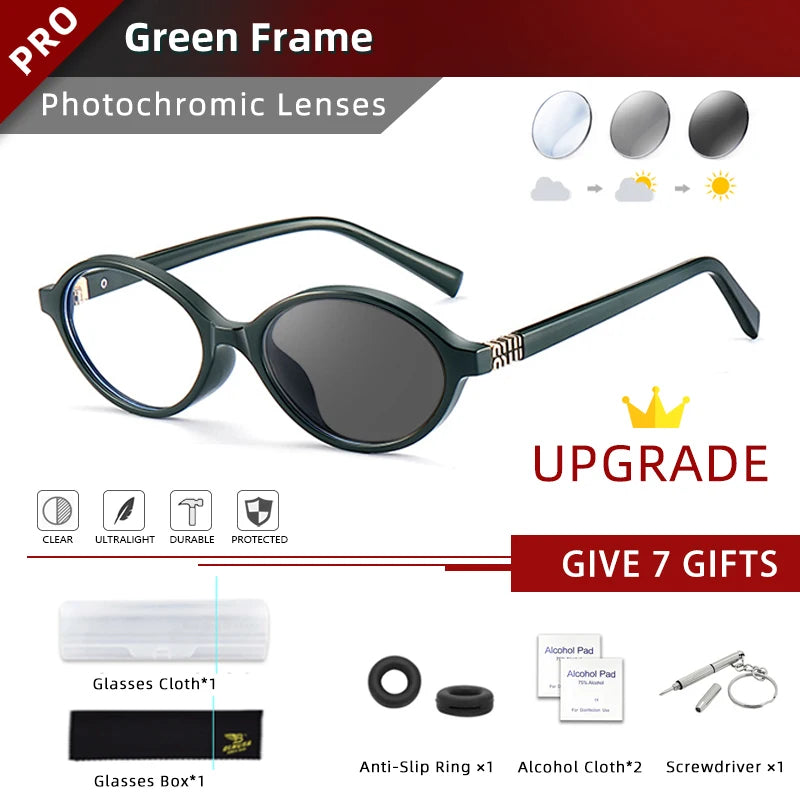Velveta
BLMUSA Retro Anti Blue Ray Photochromic Myopia Glasses Women Oval Small Frames Prescription Glasses Pop Classic Reading Glasses
BLMUSA Retro Anti Blue Ray Photochromic Myopia Glasses Women Oval Small Frames Prescription Glasses Pop Classic Reading Glasses
Couldn't load pickup availability
SPECIFICATIONS
Applicable Scenarios: Shopping
Brand Name: BLMUSA
Certification: CE
Coating: HMC
Element type: Trendy and Fashionable
Eyewear Type: Reading glasses
For other types of lenses: Please contact customer service
Frame Material: Plastic Titanium
Gender: Women
High-concerned chemical: None
Is the lens installed on the frame: Yes
Item Type: EYEWEAR
Lens Height: 3.8
Lens Index: 1.56
Lens Width: 5.1
Lenses Color: Clear
Lenses Material: CR-39
Lenses Optical Attribute: Anti-reflective
Model Number: G5691
Optional Lens Properties: Anti Blue Ray/Photochromic
Origin: Mainland China
Place Of Origin: China (mainland)
Prescription custom type: Myopia /Hyperopia
Product Type: Fashion reading glasses
Style type: Oval
You've come to the right place! We offer a rich variety of customization options.
Ontact our customer service now for a link to the lenses !!!
10.Anti-glare lenses : Reduce strong light disturbance for clear sight.































Sphere (SPH)
This indicates the strength of the lens power, measured in Diopters (D). Most typically this is written in ¼ diopter increments (I.E. 0.25, 0.50, 0.75, 1.00). This value is the prescribed amount of correction for Nearsightedness (Myopia) or Farsightedness (Hyperopia). If the number appearing under this heading has a minus sign (–), you are nearsighted; if the number has a plus sign (+) or no sign, you are farsighted. If there is no spherical correction, it could be written as 0.00 or Plano (PL).
Cylinder (CYL)
This indicates the strength of the lens power to correct Astigmatism. If nothing appears in this column, the value is 0 or "SPH" is written, it indicates that there is no astigmatism.
Optometrists usually write the astigmatic correction with a minus sign (-). Ophthalmologist usually write the value with a plus sign (+). These represent two different ways of determining the correction.
Astigmatism basically means the light coming into the eye comes to two focal points. To correct this, the lens uses the SPH power to move one of the focal points to the retina and the CYL power to move the other focal point to the retina.
Axis
The Axis number will be a value between 1 and 180. The diagram below demonstrates where those meridians are located. As you can see above, the number 90 corresponds to the vertical meridian of the eye, and the number 180 corresponds to the horizontal meridian. To avoid mistakes, the axis is typically written as 3 digits. For example, an axis value of 45 is usually written as 045.
Near Add or NV-ADD
This is the added magnifying power applied to the bottom part of Bifocal, Trifocal or Progressive lenses to correct presbyopia. The number appearing in this section of the prescription is always a plus power, even if it is not preceded by a plus sign (+). The add power is usually the same for both eyes, however in certain rare occasions it could be different between the 2 eyes.
A brief description of presbyopia is the acquired inability to focus on close objects. Presbyopia is a natural aging change within the eyes. There is no way to prevent it and it happens progressively over time. Presbyopia typically starts to affect people around age 40


Share


























































































